2012中考一轮复习精品课件(含2011中考真题)英语仁爱版七上(112张ppt)
文档属性
| 名称 | 2012中考一轮复习精品课件(含2011中考真题)英语仁爱版七上(112张ppt) | 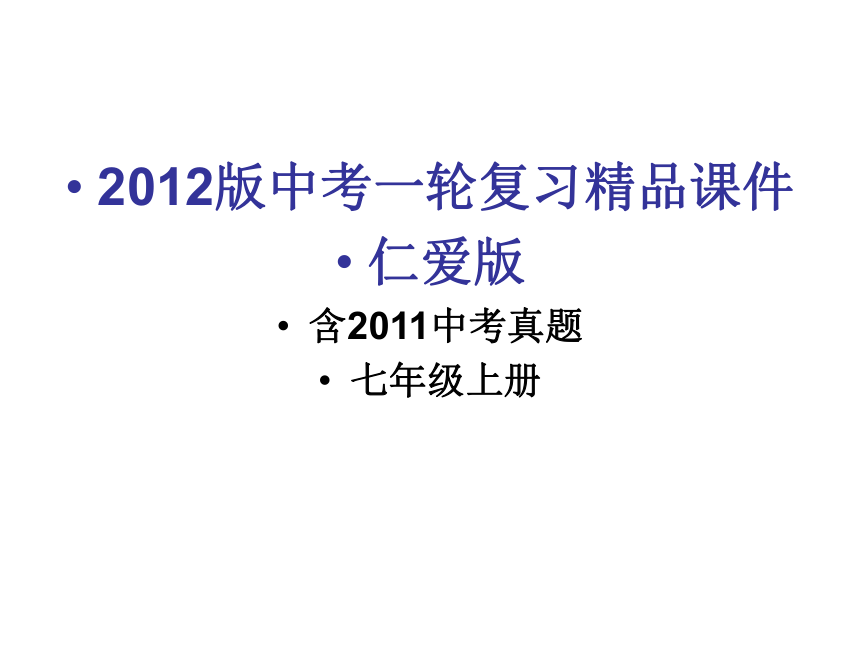 | |
| 格式 | rar | ||
| 文件大小 | 612.7KB | ||
| 资源类型 | 教案 | ||
| 版本资源 | 通用版 | ||
| 科目 | 英语 | ||
| 更新时间 | 2012-01-12 10:41:39 | ||
图片预览

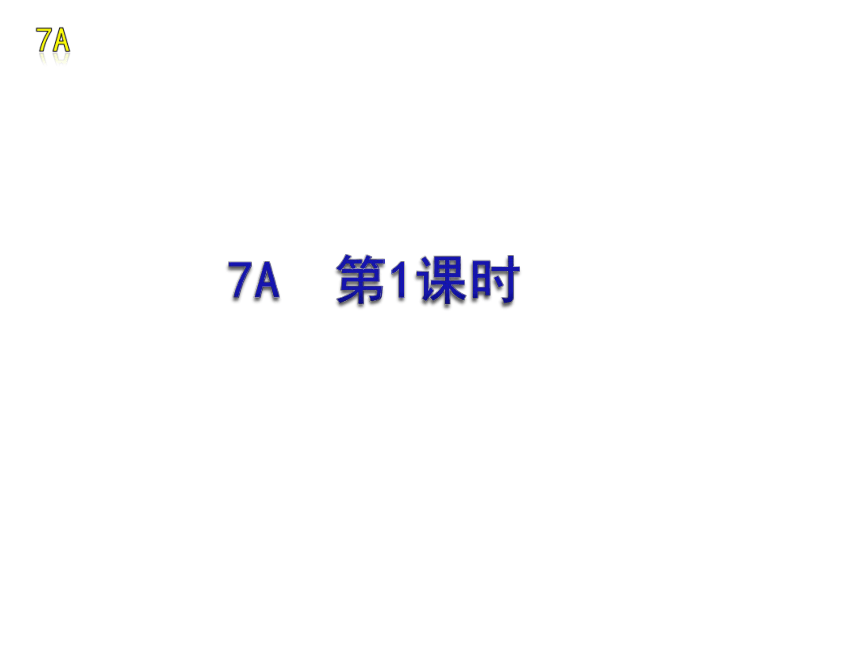
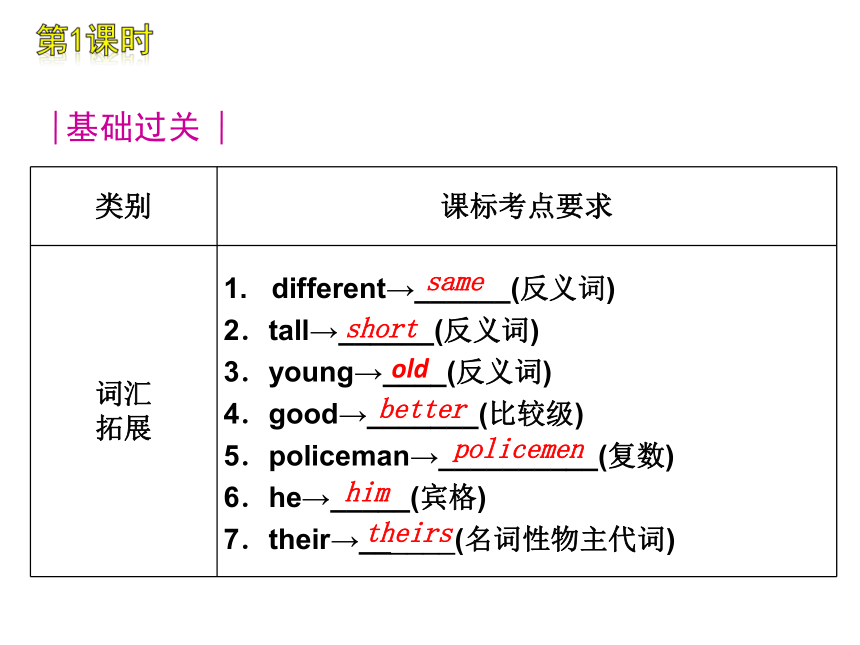
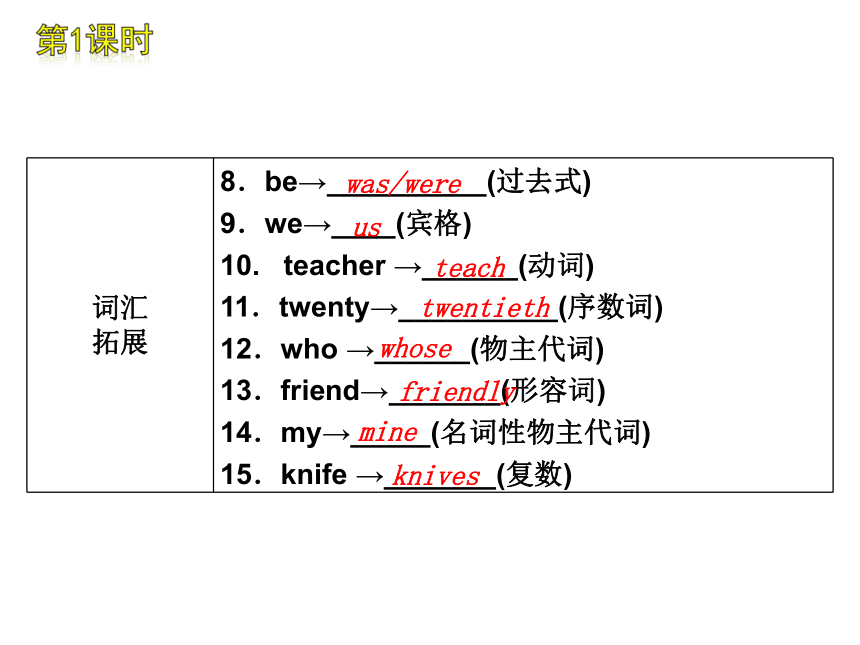
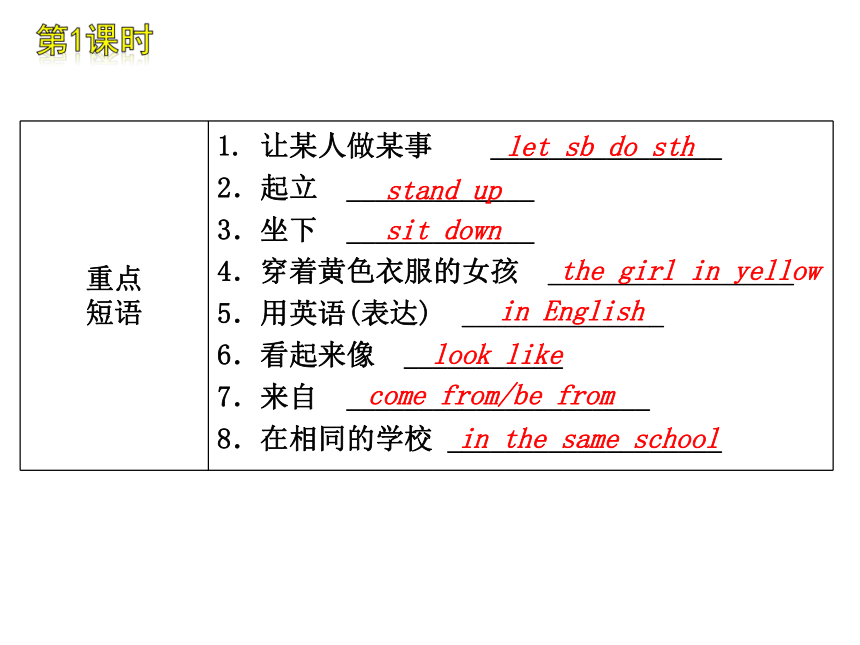
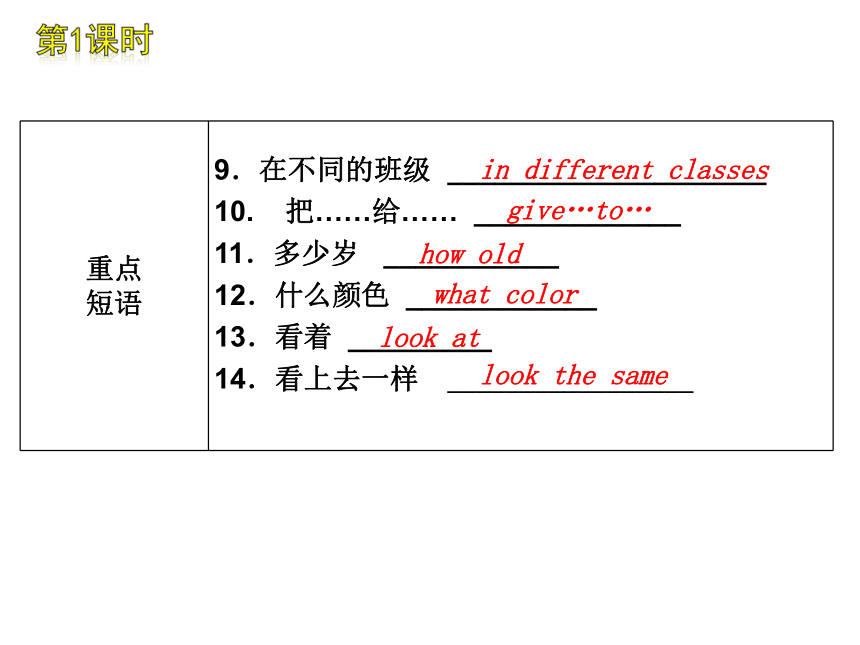
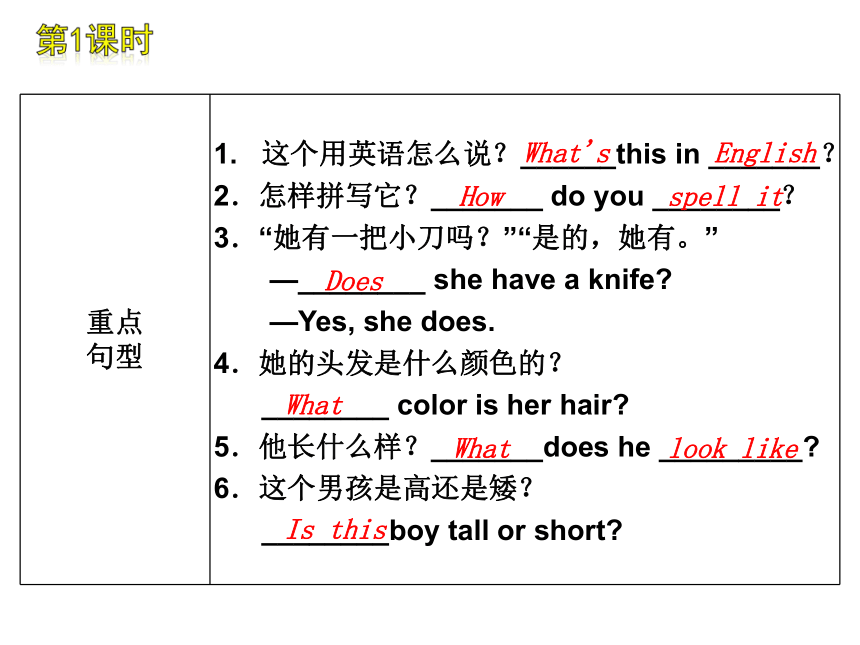
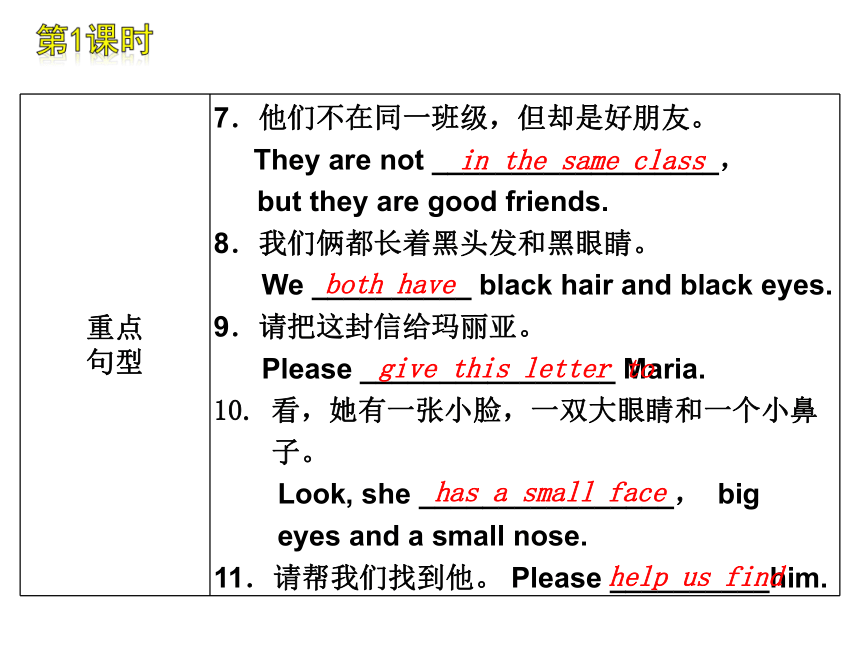

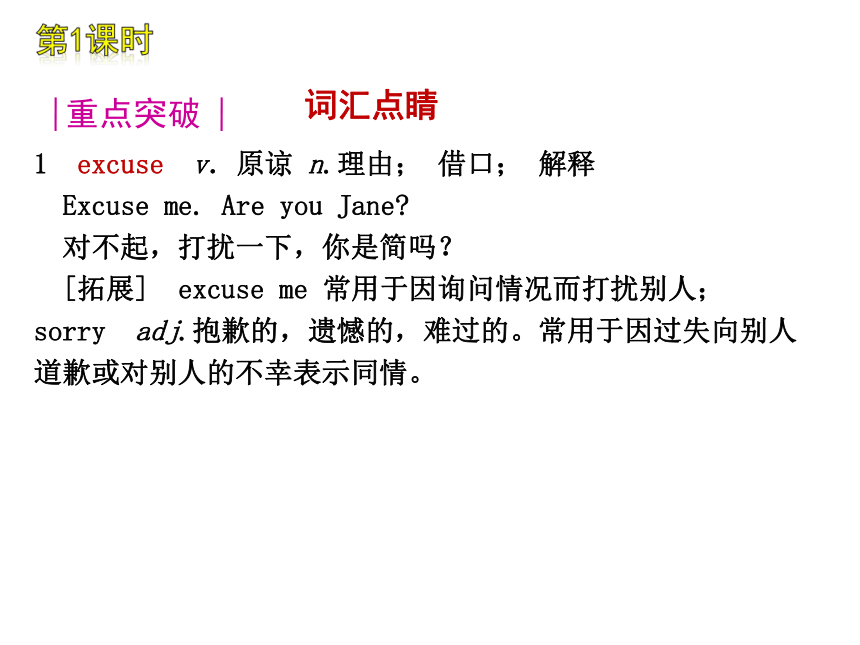
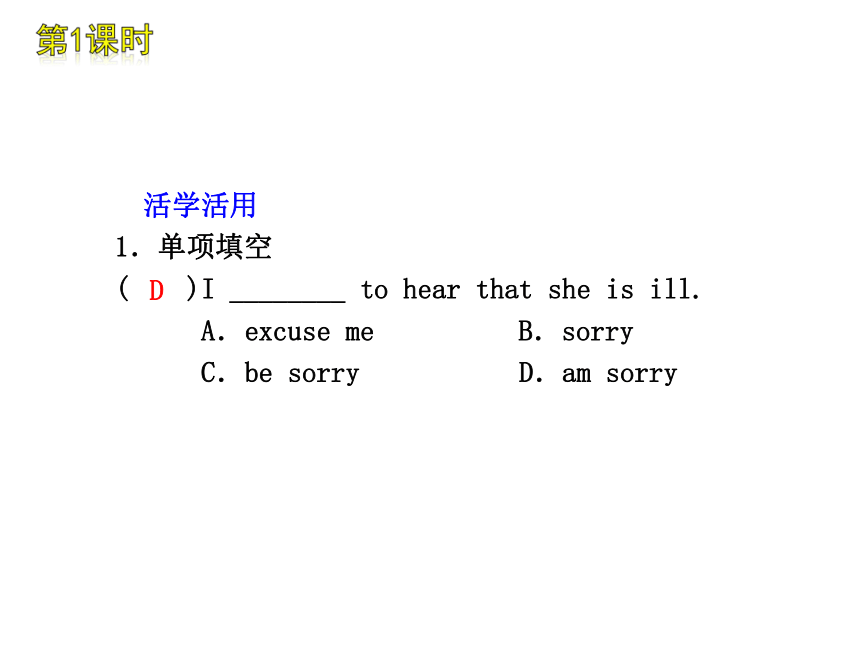
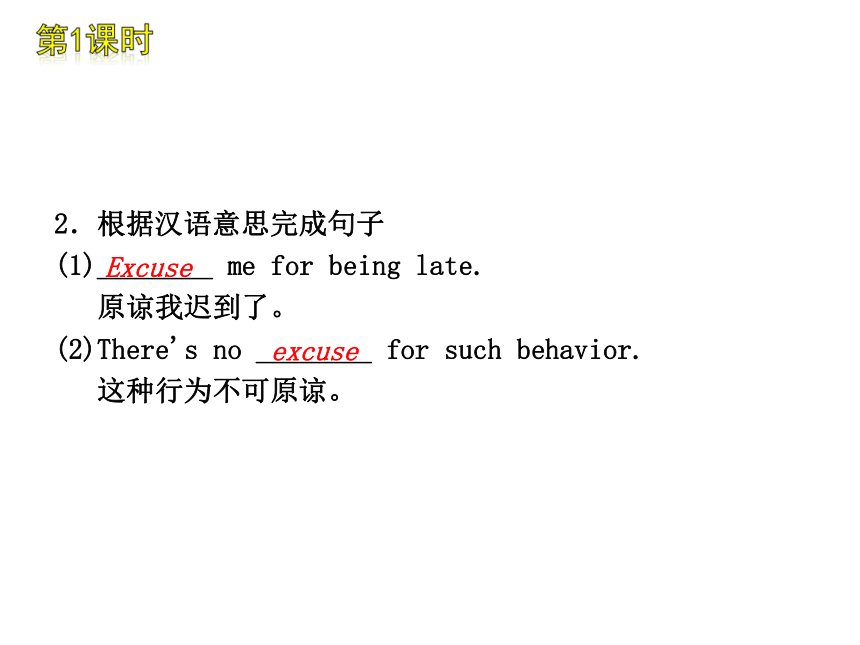
文档简介
(共112张PPT)
2012版中考一轮复习精品课件
仁爱版
含2011中考真题
七年级上册
·福建省专用
基础过关
·福建省专用
类别 课标考点要求
词汇
拓展 1. different→______(反义词)
2.tall→______(反义词)
3.young→____(反义词)
4.good→_______(比较级)
5.policeman→__________(复数)
6.he→_____(宾格)
7.their→______(名词性物主代词)
same
short
old
better
policemen
him
theirs
·福建省专用
词汇
拓展 8.be→__________(过去式)
9.we→____(宾格)
10. teacher →______(动词)
11.twenty→__________(序数词)
12.who →______(物主代词)
13.friend→_______(形容词)
14.my→_____(名词性物主代词)
15.knife →_______(复数)
was/were
us
teach
twentieth
whose
friendly
mine
knives
·福建省专用
重点
短语
1. 让某人做某事 ________________
2.起立 _____________
3.坐下 _____________
4.穿着黄色衣服的女孩 _________________
5.用英语(表达) ______________
6.看起来像 ___________
7.来自 _____________________
8.在相同的学校 ___________________
let sb do sth
stand up
sit down
the girl in yellow
in English
look like
come from/be from
in the same school
·福建省专用
重点
短语 9.在不同的班级 ____________________
10. 把……给…… _____________
11.多少岁 ___________
12.什么颜色 ____________
13.看着 _________
14.看上去一样 _________________
in different classes
give…to…
how old
what color
look at
look the same
·福建省专用
重点
句型 1. 这个用英语怎么说?______this in _______?
2.怎样拼写它?_______ do you ________?
3.“她有一把小刀吗?”“是的,她有。”
—________ she have a knife
—Yes, she does.
4.她的头发是什么颜色的?
________ color is her hair
5.他长什么样?_______does he _________
6.这个男孩是高还是矮?
________boy tall or short
What's
English
How
spell it
Does
What
What
look like
Is this
·福建省专用
重点
句型 7.他们不在同一班级,但却是好朋友。
They are not __________________,
but they are good friends.
8.我们俩都长着黑头发和黑眼睛。
We __________ black hair and black eyes.
9.请把这封信给玛丽亚。
Please ________________ Maria.
看,她有一张小脸,一双大眼睛和一个小鼻
子。
Look, she ________________, big
eyes and a small nose.
11.请帮我们找到他。 Please __________him.
in the same class
both have
give this letter to
has a small face
help us find
·福建省专用
语法
结构 1. 形容词性物主代词和名词性物主代词的用法。
[ 详见P70,语法互动(二)]
2.冠词的基本用法。[详见P72,语法互动(三)]
3.可数名词复数形式、名词所有格。
[详见P69, 语法互动(一)]
·福建省专用
词汇点睛
1 excuse v.原谅 n.理由; 借口; 解释
Excuse me. Are you Jane
对不起,打扰一下,你是简吗?
[拓展] excuse me 常用于因询问情况而打扰别人;
sorry adj.抱歉的,遗憾的,难过的。常用于因过失向别人
道歉或对别人的不幸表示同情。
重点突破
·福建省专用
活学活用
1.单项填空
( )I ________ to hear that she is ill.
A.excuse me B.sorry
C.be sorry D.am sorry
D
·福建省专用
2.根据汉语意思完成句子
(1)________ me for being late.
原谅我迟到了。
(2)There's no ________ for such behavior.
这种行为不可原谅。
Excuse
excuse
·福建省专用
2 from prep.从;从……起
Where are you from 你来自哪里?
[拓展] be from=come from 来自
from…to… 从……到……
be far from… 离……远
hear from… 收到……的来信
·福建省专用
活学活用
1.根据汉语意思完成句子
(1)She ______________ Japan.
她来自日本。
(2)It's three kilometers _____ my home ____ school.
从我家到学校有三公里远。
(3)Hunan is far _______Beijing.
湖南离北京很远。
2.根据句意及汉语提示完成句子
She ____________(收到……来信)her pen
friend yesterday.
comes/is from
from
to
from
heard from
·福建省专用
3 too adv. 也,还;太,过分;很,非常
Nice to meet you,too.见到你也很高兴。
[辨析] also,too与either
also较正式,用于肯定句,位于行为动词前,系动词、助动词、情态动词后。
too较普通,口语化,用于肯定句和问句末,其前用逗号。
either用于否定句末,其前用逗号。
·福建省专用
活学活用
选词填空(too, also, either)
(1)Are you in Grade Two, _____?
(2)It isn't Kangkang's , ________.
(3)Mom, my dress is _____short.
(4)I'm not _____ sure if this is right.
(5)He can _____ drive a car.
too
either
too
too
also
·福建省专用
4 in prep. 在……里(内;上);用……(表达);穿着
I am in Class Four, Grade Seven.
我在七年级四班。
[点拨] “in+地点”表示“在某地,属于……”; “in+语言”表示“用……表达”;“in+颜色/衣服 ”表示“穿着……”。
·福建省专用
活学活用
根据汉语意思完成句子
(1)My pen is ___________.
我的钢笔在盒子里。
(2)________ this ___ English
这个用英语怎么表达?
(3)The girl __________is my elder sister.
穿绿色衣服的女孩是我的姐姐。
in the box
What's
in
in green
·福建省专用
5 like prep.像…… v.喜欢
What does she look like 她长什么样?
[拓展] look like 看起来像
be like 像……
Would you like…? 你想要……吗?
feel like 想要
seem like 好像
·福建省专用
活学活用
根据汉语意思完成句子
(1)The little boy ___________ his mother.
这个小男孩长得像他妈妈。
(2)I _____ English ______.
我最喜欢英语。
looks like
like
best
·福建省专用
6 hair n. 头发
He has small eyes and short hair.
他有一双小眼睛,短头发。
[点拨] 一般用作不可数名词,但要特别强调有几根特殊或不 同的头发时,用作可数名词。
[拓展] brush one's hair 梳理头发
·福建省专用
活学活用
根据汉语意思完成句子
(1)There's _______in my soup.
我的汤里有根头发。
(2)There are a few grey hairs among his
__________.
在他的黑发中有几根灰白的头发。
a hair
black hair
·福建省专用
7 with prep. 有……;带有;和;用
She is young with long legs.
她年轻,双腿修长。
[点拨] (1)with+sth “有……”;“带有……”
(2)with+sb “和某人(一起)”
(3)with+有形工具/身体器官 “用……”
·福建省专用
活学活用
1.单项填空
( ) [ 2011 铜仁]—What does your English teacher look
like
— She's tall and thin ________ long hair.
A.have B.has C.there is D.with
D
·福建省专用
2.根据汉语意思完成句子
(1) He has a house________________.
他有一所带有花园的房子。
(2) I want to go shopping__________.
我想和你去购物。
(3)You shouldn't write____________________.
你不该用左手写字。
with a garden
with you
with your left hand
·福建省专用
8 have v. 有;吃,喝
[点拨] 表示“某人或物拥有……”;当主语是第三人称单数时,应用has表示“拥有”。
[拓展] 主语+have/has+sth 某人/物有……
There be+sth+地点 在某地有某物
[注意] 动词have(有)不能与 there be(有)同时用在一个句子中。
·福建省专用
活学活用
根据汉语意思完成句子
I ______a big nose. She _____ a small mouth.
我长着一个大鼻子。她长着一张小嘴巴。
have
has
·福建省专用
9 one num. & pron. 一; 一个
—Bring my bag here, please.
把我的包带到这里。
—Which one
哪个包?
—The blue one.
蓝色的那个。
[点拨] (1)表示数量“一”。
(2)one可用来代替上文提到的同类事物或人,复数用ones
来代替。
·福建省专用
活学活用
1. 单项填空
( )(1)—Excuse me.I want to buy some stamps. Where
can I find a post office
—I know ________not far from here. You can
easily find ________.
A.that; it B.it; one C.one; it D.a; it
( )(2)I'm expecting a pet dog for long,but mom
has no time to buy ________ for me.
A.it B.on C.this D.that
C
B
·福建省专用
2.选词填空(one,ones,it,that)
(1)There's only _____ boy in the class.
(2)I don't like red apples. Please give me some
green_______.
one
ones
·福建省专用
10 color (colour) n.颜色v.给……着色
What color is his hair 他的头发是什么颜色的?
[拓展] colorful adj. 五颜六色的;色彩鲜艳的
活学活用
根据汉语意思完成句子
(1)—______________ it
—It's red.
“它是什么颜色的?”“红色的。”
What color is
·福建省专用
(2)Please _______ this wall _______.
请把这面墙壁涂成绿色。
(3)This old woman wears ________ clothes because she
wants to be young and beautiful.
这位老妇人穿着颜色鲜艳的衣服,因为她想年轻漂亮。
color
green
colorful
·福建省专用
11 the art. 这(那)个;这(那)些
—Which girl?哪个女孩?
—The one in green.穿绿衣服的那个女孩。
活学活用
( ) [ 2011·济宁] I like music, but I don't like
______ music of this film.
A.a B.An C.the D.不填
C
·福建省专用
12 a, an art. 一(个,件……)
[点拨] a通常用于以辅音音素开头的单词前,an通常用
于以元音音素开头的单词前。
This is a Chinese book. 这是一本语文书。
I often eat an apple in the morning.
我经常在早晨吃一个苹果。
·福建省专用
活学活用
( )(1)Lady Gaga is ________very popular
singer. She has lots of fans.
A.a B.an C.the D./
( )(2)Photography can be ________excellent hobby
for kids.
A./ B.a C.an D.the
A
C
·福建省专用
13 Let's … 让我们……
Let's meet at 9 o'clock.我们九点见面吧。
[拓展] let's是let us的缩写,但let's与let us两者的实际含义并不相同。let's用来提建议,建议听话者与说话者共同干某事; let us则用来表示请求,即说话者向听话者请求允许去干某事,不包含听话者。
·福建省专用
活学活用
完成下列反意疑问句
(1) Let's go to school,_________?
(2) Let us look after you,_________?
shall we
will you
·福建省专用
14 well adv. & adj. 好
[点拨] (1)adj.身体好,健康的
My mother is not quite well.
我母亲的身体不太好。
(2)adv. 好,令人满意地
She paints well.她绘画很好。
[注意] well还可作interj.(表示让步,同意,慰藉,
惊愕等)好吧,嗯,唉。
Well, let's go.好吧,让我们出发。
·福建省专用
活学活用
1.根据汉语提示完成句子
(1)Your handwriting is very ______(好的).
(2)Miss Le is a _______(好的) woman.
(3)I can sing very ______(好).
(4)—How is your father
—He is very_______(好).
2.用所给词的适当形式填空
Dick does ______ (well) in math than me.
good
good
well
well
better
·福建省专用
15 thank v. 感谢
[拓展] thanks n. 感谢
thanks to 由于,多亏
thanks for=thank sb for 因为……而感谢(某人)
·福建省专用
活学活用
根据汉语意思完成句子
(1)You should ________ your parents.
你应该感谢你的父母。
thank
·福建省专用
(2)___________ our teachers,we passed the final exam.
多亏老师的帮助,我们通过了期末考试。
(3)____________ your help.
感谢你的帮助。
Thanks to
Thanks for
·福建省专用
16 be(am,is,are) v. 是
[点拨] be动词在一般现在时态中有三种形式:am,is,are.
主语是第一人称I时用am,主语是第二人称you及复数形式时用are,主语是第三人称单数时用is。
·福建省专用
活学活用
选词填空(am,is,are)
(1)Where _____ Mr. Black and Mrs. Green
(2)My hair ____long and my feet ______big.
(3)I _____reading in the study now.
are
is
are
am
·福建省专用
1 What's your name?你叫什么名字?
[点拨] 用来询问对方的姓名,还可以这样说:May I know your name?/May I have your name
2 This is my teacher. 这是我的老师。
[点拨] “This is…”用来介绍某人,意为“这位是……”。
句型透视
·福建省专用
活学活用
根据汉语意思完成句子
Lucy, ________ Maria.
露西,这位是玛丽亚。
this is
·福建省专用
3 —How do you do 你好!
—How do you do?你好!
[点拨] 用于初次见面打招呼。其回答是How do you do 相互熟悉的人之间打招呼常用How are you?回答是Fine, thank you. And you
·福建省专用
4 —Are you Jane 你是简吗?
—Yes, I am. 是的,我是。
[点拨] 这是把be动词are提到句首的一般疑问句,通常用yes或no来进行回答。
·福建省专用
活学活用
根据汉语意思完成句子
—___he Li Ming
—No, he ______.
“他是李明吗?”“不,他不是。”
Is
isn't
·福建省专用
5 —Do you have a knife?你有小刀吗?
—Yes, I do. 是的,我有。
—Does she have a cell phone?她有手机吗?
—No, she doesn't. 不,她没有。
[点拨] 这是一般现在时行为动词的一般疑问句及其回答,句子用助动词do来完成,当主语是第三人称单数时用 does。
·福建省专用
6 What about some milk 喝点牛奶怎么样?
[点拨] What about…?相当于How about…?均意为“……怎么样?”可以用来询问情况、征求意见以及提建议,后接名词、人称代词宾格或动词 ing形式。
·福建省专用
活学活用
1.单项填空
( ) [ 2011·长沙]—What about________ a rest
—OK. Let's go out and have a walk.
A.to take B.takes C.taking
2.用所给词的正确形式填空
(1)What about _______(go)out for a walk
(2)How about ______(he)
C
going
him
·福建省专用
7 —Do you know the girl over there
你知道那边的女孩是谁吗?
—Which girl 哪个女孩?
—The girl in green. 那个穿绿衣服的女孩。
—Oh, she's Ann. 噢,她是安。
[点拨] the girl in green 是一个短语, in green用来修饰前面的the girl,意为“穿绿色衣服的女孩”。一般来说,介词短语可以放在后面修饰前面的名词。
·福建省专用
活学活用
翻译下列短语
(1)在树下的男孩_____________________
(2)带有花园的小房子__________________________
(3)在门后的那个女孩______________________
the boy under the tree
a small house with a garden
the girl behind the door
·福建省专用
8 Nice to meet you.认识你真高兴。
(用于第一次见面的客套话。)
Nice to see you.见到你真高兴。
(用于相互熟悉的人再次见面的客套话。)
·福建省专用
高频考点
( )1. [2011·福州]—I am thirsty. May I have something to
drink
—OK. Here's some ________.
A.rice B.bread C.water
( )2. [2011·江西]Come on, ________you'll be late.
A.and B.but C.or D.so
( )3. —What does Michael look like
—He has big eyes and ________ wide mouth.
A.a B.an C.the D.it
C
C
A
·福建省专用
( )4. —Whose jacket is this Is it Mr. Wang's
—No. ______ is on the desk.
A.Him B.His C.He D.He's
( )5. —Whose are these two ________?
—They are ________and________.
A.knife; Jim's; Kate's
B.knives; Jim's; Kate's
C.knives; Jim; Kate's
D.knife; Jim; kate's
B
B
考查名词复数及名词所有格,knife 的复数是knives;两把小刀分别属于Jim和Kate所有,所以要各自加上's。
·福建省专用
基础过关
·福建省专用
类别 课标考点要求
词汇
拓展 1. have→_____(第三人称单数)
2.that→______(复数)
3.here→______(反义词)
4.we→_____(名词性物主代词)
5.five→_____(序数词)
6.tomato→________(复数)
has
those
there
ours
fifth
tomatoes
·福建省专用
词汇
拓展
7.potato→________(复数)
8.drive→________(现在分词)
9.visit →_______(名词)
10. ninety →________(序数词)
11.worry →________(形容词)
potatoes
driving
visitor
ninetieth
worried
·福建省专用
重点
短语 1. 帮助某人做某事 _______________
2.顺便说(问) ___________
3.当然 __________
4.一点也不 _________
5.照看;照顾 __________
6.请便;随便吃 ____________
7.一杯咖啡 ______________
help sb with sth
by the way
of course
not at all
look after
help oneself
a cup of coffee
·福建省专用
重点
短语 8.寻找 __________
9.试穿 _______
10.吃饭 _____________
11.多少(钱) ____________
12.不得不做某事 ________________
13.没问题 _____________
14.想要做某事
________________________________
15.认为 __________
look for
try on
have dinner
how much
have to do sth
no problem
want to do sth/would like to do
think of
·福建省专用
重点
短语 16.是……的时候了 _____________
17.……怎么样 ____________
18.购物 ___________________
19.回电话…… ____________
20.在回家的途中 ___________________
it's time to…
what about
do some shopping
call…back
on one's way home
·福建省专用
重点
句型 1. 你母亲是干什么的?
__________ your mother ___?
2.你想喝点什么?
_____ would you like to ______?
3.你认为这咖啡怎么样?
______ do you _______the coffee?
/______do you like the coffee?
这块手表多少钱?
__________ is this watch
5.你的宠物长什么样?
What does your pet_________?
What does
do
What
drink
think of
What
How much
look like
How
·福建省专用
重点
句型 6.这是我的全家福。
This is ___________________.
7.我祖父母和我们住在一起并在家里照看罗丝。
My grandparents_________ us
and __________ Rose at home.
8.先生,你要吃什么?/可以点菜了吗?
May I_______________ , sir
9.为什么不试试那一条?
Why not______________?
a photo of my family
live with
look after
take your order
try on that pair
·福建省专用
重点
句型 10.恐怕我没有时间了。
I'm afraid I_____________.
11.请找玛丽亚接电话好吗?
May I _________ Maria
12.猴宝宝,你怎么了?
What's ___________ you, Baby
Monkey?
have no time
speak to
wrong with
·福建省专用
语法
结构 1. 一般现在时的用法。[详见P82,语法互动(九)]
2.不可数名词的用法。[详见P69,语法互动(一)]
3.人称代词的主格和宾格。
[详见P70,语法互动 (二)]
·福建省专用
词汇点睛
1 call v. 将……称为;给……打电话;喊,叫
Would you ask her to call me back
你能让她给我回电话吗?
重点突破
·福建省专用
活学活用
1.根据汉语意思完成句子
(1)Everyone _________ Lucy.
人人都叫我露西。
(2)I ______ you last night, but there was no reply.
我昨晚给你打电话了,但没人接听。
2.用所给词的适当形式填空
I thought I heard somebody ________(call).
calls me
called
calling
·福建省专用
2 job n. 工作;职业
My grandma doesn't have a job.
我奶奶没有工作。
[点拨] job是可数名词,可用于What's sb's job 这一句型中,用于询问某人的职业。
[拓展] work也可用作名词,意为“工作”,但work是不可数名词,不能用a/an或数词来直接修饰,“一份工作”应为a piece of work,不能说a work,但可说a job; work还可用作动词。
·福建省专用
活学活用
1.单项填空
( )(1)I want to be a reporter, because it's an
interesting________.
A.job B.work C.information D.jobs
( )(2)—Well,you look so happy!
—Because I got a good ________.
A.work B.news C.job D.works
2.根据汉语意思完成句子
I'm busy. I have a lot of ________ to do.
我忙着呢。我有许多工作要做。
A
C
work
·福建省专用
time n.时间(不可数名词);次数,次,回,倍数
(可数 名词)
What time is it 几点了?
[拓展] once 一次;this time 这一次; next time 下一次;twice 两次;five times 五次(三次或三次以上用times表示)
·福建省专用
活学活用
( )This book is ________as expensive as that one.
A.three times B.three time
C.second times D.two time
A
句意为:这本书是那本书价钱的三倍。time作“次数或倍数”讲是可数的。
·福建省专用
4 both pron. & adj. 两者; 双方
My parents are both office workers.
我父母都是办公室职员。
[点拨] both适用范围是“两者”。作主语时,谓语动词用复数,作定语时,后面的名词用复数。
[拓展] all适用于三者或三者以上,意为“都……”。
·福建省专用
活学活用
1.单项填空
( ) [ 2011·武汉]—The teachers in that school speak either
English or French, or even ________.
—That's so cool!
A.all B.both C.neither D.none
2.根据汉语意思完成句子
(1)_______of the students are from the UK.
这两名学生都来自英国。
(2)My sisters and I are _____at school.
我和我的姐妹们都在上学。
B
Both
all
·福建省专用
5 never adv. 从来不; 决不
He never speaks English. 他从不说英语。
[点拨] never 本身是一个表否定的词,故一般不再与not连用;一般放在行为动词之前,be动词、助动词、情态动词之后。
·福建省专用
活学活用
1.单项填空
( ) [ 2011·襄阳]—Bob is ________ late for school.
—Me neither.
A.always B.almost C.ever D.never
2.完成反意疑问句
He is never late for school, _____?
D
is he
·福建省专用
6 favorite adj.最喜欢的;n.特别喜欢的人或事物
Monkeys are my favorite animals.
猴子是我最喜欢的动物。
[点拨] favorite作名词,意思是“最喜欢的人或物”; 作形容词,意为“最喜欢的”,后接名词,可与like…best/most进行同义转换。
·福建省专用
活学活用
( )Superhero is ________.
A.I favorite B.me favorite
C.my favorite D.my most favorite
C
·福建省专用
7 some与any
[辨析] 两者都可表示“一些”之意。一般来说,some用于肯定句,any用于否定句和疑问句中。但以下情况只能用some,不能用any:
(1)提建议;
(2)提出请求,并希望得到对方的肯定回答。
另外,some还可表示“某一”之意,any还可表示“任何一个”之意。
·福建省专用
活学活用
1.单项填空
( )(1)I'm very thirsty. Could you give me
_____ water
A.any B.some C.many D.Much
B
句意为:我很渴。你能给我点儿水喝吗?Could/Would you…?中习惯用some,此处表示希望得到对方的肯定回答。
·福建省专用
( )(2)Phone me________ day next week.
A.any B.some C.many D.Much
A
句意为:下星期随便哪天给我打个电话。any 用于肯定句中常表示“任何”。
·福建省专用
2.根据汉语意思完成句子
(1)I have ______ interesting books.
我有一些有趣的书。
(2)She doesn't have _____ brothers.
她没有兄弟。
(3)Would you like _______ bread
你想要些面包吗?
some
any
some
·福建省专用
8 a little与a few
[辨析] 两者均为肯定意义。a few修饰可数名词复数,a little修饰不可数名词,都表示“一些,少数”之意。另外,a little 还可用作程度副词,修饰形容词、副词或比较级,还可修饰动词。
little和few均是否定意义,表示“几乎没有”。
·福建省专用
活学活用
1.单项填空
( ) [ 2011·河北]We'd better wait ________ more minutes. I
think Jeff will come soon.
A.a few B.few C.a little D.little
2.选词填空(few,little,a few ,a little)
(1)There is ______ water in the bottle.
瓶子里有一点儿水。
(2)There are ______ grapes in the plate.
盘子里有一些葡萄。
(3)_____people live to be 150.几乎没有人能活到150岁。
(4)There is _____orange in the bottle. We have
to buy some.瓶子里几乎没有橘汁了,我们必须买一些。
A
a little
a few
Few
little
·福建省专用
9 tell, speak, talk与say
[辨析] tell意为“告诉; 讲(故事,笑话)”,是及物动词,后面应有宾语,可用于tell sb about sth 结构中,意为“告诉某人关于某事”。
speak意为“说”,强调说话的能力,是不及物动词,后面跟介词to/with,意为“与……谈话”;作“(会)说,(会)讲(某种语言)” 时是及物动词。
talk意为“谈话,交流”,是不及物动词,后面跟介词to/with,表示“与某人谈话”;talk about 意为“谈论……”。
say意为“说”,是及物动词,强调说话的内容,与介词to搭配,意为“对……说”。
·福建省专用
活学活用
1.单项填空
( )(1)My mother is ________to/with my teacher.
A.talking B.speaking
C.telling D.saying
( )(2) [ 2011·滨州]—Shall we go and _____ hello to the
foreign teachers
—Good idea! Let's go.
A.say B.speak
C.talk D.Shout
A
A
考查短语用法。say hello to sb 是固定搭配,意为“向某人问好/打招呼”。
·福建省专用
2.根据汉语意思完成句子
(1)My grandmother often ____ me stories in the
evening.
晚上我祖母经常给我讲故事。
(2)By the way, do you _______ Chinese
顺便问一下,你说汉语吗?
(3)On the bus, they ____________ different animals in
the zoo.
在公共汽车上,他们谈论动物园里的各种动物。
tells
speak
talked about
·福建省专用
10 how many 多少(问数量)
How many bottles do we need
我们需要多少个瓶子?
[点拨] 后面跟可数名词的复数形式,意为“多少”。
[拓展] 问不可数名词有“多少”时,用“how much”。 how much还可对价钱提问,意为“多少钱”。
·福建省专用
活学活用
( ) [ 2011·绵阳]—________ does the baby mouse
weigh
—About 20 grams.
A.How much B.How many
C.How D.What
B
疑问词的用法。how much提问不可数名词的数量即后跟不可数名词,还可提问“价格”;how many提问可数名词的数量即后跟可数名词复数;how 意思是“怎样”;what意思是“什么”。根据答句“about 20 grams”意思是“大约20克”, grams是可数名词复数可推断提问多少克,故选B。
·福建省专用
11 people n. 人,人民
There are five people in my family.
我家有五口人。
[点拨] (1)people 表示“人”时是集合名词,为复数。
(2)people 表示“民族”时有单复数形式。
a/one people一个民族
·福建省专用
活学活用
(1)________________ boy is honest.
人们说那个男孩是诚实的。
(2)China has____________.
中国有56个民族。
People say that
56 peoples
·福建省专用
12 Mr. n. 先生
[拓展] (1)Mr. 先生,用在男性姓氏的前面。
(2)Miss用在未婚女性姓氏的前面。
(3)Mrs.用在已婚女性姓氏的前面。
·福建省专用
1 —What do your parents do
你的父母是做什么工作的?
—They are both office workers.
他们俩都是办公室职员。
[点拨] What do/does…do?该句型用来询问某人的职业。
[拓展] 动词后加er就变为从事该工作的人。以e结尾的动词,后加r。如:player,worker,driver,writer,winner;但个别名词是加or,如:visitor,inventor。
句型透视
·福建省专用
2 Why not have some milk
为什么不来点牛奶?
[点拨] “Why not+动词原形?”相当于“Why don't you+动词原形?”表示征求对方意见或建议,意为“为什么不……呢?”
Why not go upstairs and have a look
为何不上楼去看一看?
·福建省专用
3 —What do you think of the coffee
你觉得这咖啡怎么样?
—Not bad. 不错。
[点拨] 询问别人的观点或对某人或某事进行评价常用以下
句型:
What do you think of…?意为“你认为……怎么样”,相当于
How do you like…?
How do you like the fish 你觉得这鱼做得怎么样?
What do you think of Beijing Opera
你认为京剧怎么样?
·福建省专用
4 —Would you like to have dinner with me
你愿意和我一起进餐吗?
—OK, I'd love to. 好的,我愿意。
[点拨] “Would you like+动词不定式”这一句型用来询问别人愿不愿意、想不想做某事;其回答一般用“Yes, I'd love/like to.”;若有事不能去做某事,其回答为“I'd love/like to, but…”but后接原因。
—Would you like to go swimming with me
你愿意和我一起去游泳吗?
—Yes, I'd love/like to.
是的,我愿意。
·福建省专用
—Would you like to watch movies
你想看电影吗?
—I'd love/like to, but I have a lot of homework to do. 是的,我想去,但是我有许多作业要做。
[拓展] Would you like…?
Why not/don't you…?
What/How about…?
均为提建议的句型,用some而不能用any。
·福建省专用
5 Here it is. 在这儿。
[点拨] 此句是倒装句。正常的语序应是“It is here.”通常为了强调某一句子成分,把该成分提前。当把here或there提到句首,且主语是名词时,主谓要完全倒装。若主语是代词,则主谓不倒装。
Here is the news. 现在播报新闻。
There they are! 他们在这儿呢!
·福建省专用
活学活用
( )Hey, Nick. ________ is the address of your hotel.
Don‘t lose it.
A.This B.Here C.That D.It
B
以here/there开头的句子,主语是名词,通常完全倒装。
·福建省专用
6 Hello,Jane! This is Kangkang.
你好, 简!我是康康。
[点拨] 这是电话用语,“我是……”要用“This is…”或“This is…speaking.”询问对方是谁时用“Who's that / this ”
—Hello! This is John. Who's that
你好!我是约翰。你是谁呀?
—This is Maria. May I speak to your brother, Jim
我是玛丽亚。我可以和你哥哥吉姆通话吗?
·福建省专用
活学活用
( ) [ 2011·武汉]—Hello,this is Wendy. Can I speak to
Jessica
—Yes,______.
A.Jessica is me
B.Jessica,please
C.my name is Jessica
D.this is Jessica speaking
D
·福建省专用
7 It's time to go home. 该回家了。
[点拨] It's time to do sth. 是固定结构,意为“该做……了,该是……时候了”,其同义结构是“It's time for+名词”。
It's time to have a class. 该上课了。
It's time for class. 该上课了。/上课时间到了。
·福建省专用
8 —What time is it?现在几点了?
—It's a quarter past eight. 现在八点十五分。
[点拨] 问几点还可以用What's the time
[拓展] 时间表达法有两种:
(1)用数字表达几点几分,如:10:20—ten twenty; 5:30—five thirty。
·福建省专用
(2)当分钟数≤30时,用“分钟数+past+点钟数”表示“几点超过几分”;
当分钟数>30时,用“60减去分钟数+to+下一个点钟数”表示“还差……分钟就几点了”。
此外,用half表示“半点钟”,用a quarter 表示“一刻钟”,
如:8:15—a quarter past eight;
12:30—half past twelve;
5:45—a quarter to six。
·福建省专用
高频考点
( )1.—Mom,I like the yellow pants. Can I _______?
—Sure.
A.try on it B.try it on
C.try on them D.try them on
D
本题考查try on这一短语,代词要放在中间,且用宾格。根据句意“我喜欢这条黄色的裤子”,“裤子”是复数,所以代词用them。
·福建省专用
( )2.—Would you like something to drink
—Yes,I'd like ________.
A.two bottle of beer B.two bottles of beer
C.a piece of cake D.a cup of milks
B
milk和beer是不可数名词,故不能加s,两瓶应用“two bottles of”。
·福建省专用
( )3. [ 2011·天津]— Is this ________ ruler
—No. ________ is over there.
A.her; Her B.her; Hers
C.hers; Hers D.hers; Her
B
考查物主代词的用法。形容词性物主代词后要接名词,而名词性物主代词后则不用跟名词。
·福建省专用
( )4. [ 2011·北京] I'm talking to you, Jack. Please listen
to________ carefully.
A.me B.mine
C.you D.yours
A
本题考查代词的用法。这里是在listen to后做宾语,需要人称代词宾格,与“我”对应的只能是答案A。
·福建省专用
( )5.—Can your father drive
—Yes, and he ________ to work every day.
A.is driving B.drove
C.drives D.has driven
由时间状语every day 可知“每天开车上班”故应用一般现在时。
C
·福建省专用
( )6.—________milk do you want
—Three.
A.How many bags of
B.How much bags of
C.How many
D.How much
本题考查 how many和 how much的用法。根据回答“Three.”可推断出是问“你要多少袋牛奶?”,所以选A。
A
·福建省专用
( )7. [ 2011·上海] Now my father ________ his bike to
work every day instead of driving.
A.ride B.rode
C.rides D.will ride
考查一般现在时的用法。every day意为“每天”,表示经常性,习惯性的动作,故该句子要使用一般现在时,主语为第三人称单数,故答案选C;选项B、D时态错误。
C
2012版中考一轮复习精品课件
仁爱版
含2011中考真题
七年级上册
·福建省专用
基础过关
·福建省专用
类别 课标考点要求
词汇
拓展 1. different→______(反义词)
2.tall→______(反义词)
3.young→____(反义词)
4.good→_______(比较级)
5.policeman→__________(复数)
6.he→_____(宾格)
7.their→______(名词性物主代词)
same
short
old
better
policemen
him
theirs
·福建省专用
词汇
拓展 8.be→__________(过去式)
9.we→____(宾格)
10. teacher →______(动词)
11.twenty→__________(序数词)
12.who →______(物主代词)
13.friend→_______(形容词)
14.my→_____(名词性物主代词)
15.knife →_______(复数)
was/were
us
teach
twentieth
whose
friendly
mine
knives
·福建省专用
重点
短语
1. 让某人做某事 ________________
2.起立 _____________
3.坐下 _____________
4.穿着黄色衣服的女孩 _________________
5.用英语(表达) ______________
6.看起来像 ___________
7.来自 _____________________
8.在相同的学校 ___________________
let sb do sth
stand up
sit down
the girl in yellow
in English
look like
come from/be from
in the same school
·福建省专用
重点
短语 9.在不同的班级 ____________________
10. 把……给…… _____________
11.多少岁 ___________
12.什么颜色 ____________
13.看着 _________
14.看上去一样 _________________
in different classes
give…to…
how old
what color
look at
look the same
·福建省专用
重点
句型 1. 这个用英语怎么说?______this in _______?
2.怎样拼写它?_______ do you ________?
3.“她有一把小刀吗?”“是的,她有。”
—________ she have a knife
—Yes, she does.
4.她的头发是什么颜色的?
________ color is her hair
5.他长什么样?_______does he _________
6.这个男孩是高还是矮?
________boy tall or short
What's
English
How
spell it
Does
What
What
look like
Is this
·福建省专用
重点
句型 7.他们不在同一班级,但却是好朋友。
They are not __________________,
but they are good friends.
8.我们俩都长着黑头发和黑眼睛。
We __________ black hair and black eyes.
9.请把这封信给玛丽亚。
Please ________________ Maria.
看,她有一张小脸,一双大眼睛和一个小鼻
子。
Look, she ________________, big
eyes and a small nose.
11.请帮我们找到他。 Please __________him.
in the same class
both have
give this letter to
has a small face
help us find
·福建省专用
语法
结构 1. 形容词性物主代词和名词性物主代词的用法。
[ 详见P70,语法互动(二)]
2.冠词的基本用法。[详见P72,语法互动(三)]
3.可数名词复数形式、名词所有格。
[详见P69, 语法互动(一)]
·福建省专用
词汇点睛
1 excuse v.原谅 n.理由; 借口; 解释
Excuse me. Are you Jane
对不起,打扰一下,你是简吗?
[拓展] excuse me 常用于因询问情况而打扰别人;
sorry adj.抱歉的,遗憾的,难过的。常用于因过失向别人
道歉或对别人的不幸表示同情。
重点突破
·福建省专用
活学活用
1.单项填空
( )I ________ to hear that she is ill.
A.excuse me B.sorry
C.be sorry D.am sorry
D
·福建省专用
2.根据汉语意思完成句子
(1)________ me for being late.
原谅我迟到了。
(2)There's no ________ for such behavior.
这种行为不可原谅。
Excuse
excuse
·福建省专用
2 from prep.从;从……起
Where are you from 你来自哪里?
[拓展] be from=come from 来自
from…to… 从……到……
be far from… 离……远
hear from… 收到……的来信
·福建省专用
活学活用
1.根据汉语意思完成句子
(1)She ______________ Japan.
她来自日本。
(2)It's three kilometers _____ my home ____ school.
从我家到学校有三公里远。
(3)Hunan is far _______Beijing.
湖南离北京很远。
2.根据句意及汉语提示完成句子
She ____________(收到……来信)her pen
friend yesterday.
comes/is from
from
to
from
heard from
·福建省专用
3 too adv. 也,还;太,过分;很,非常
Nice to meet you,too.见到你也很高兴。
[辨析] also,too与either
also较正式,用于肯定句,位于行为动词前,系动词、助动词、情态动词后。
too较普通,口语化,用于肯定句和问句末,其前用逗号。
either用于否定句末,其前用逗号。
·福建省专用
活学活用
选词填空(too, also, either)
(1)Are you in Grade Two, _____?
(2)It isn't Kangkang's , ________.
(3)Mom, my dress is _____short.
(4)I'm not _____ sure if this is right.
(5)He can _____ drive a car.
too
either
too
too
also
·福建省专用
4 in prep. 在……里(内;上);用……(表达);穿着
I am in Class Four, Grade Seven.
我在七年级四班。
[点拨] “in+地点”表示“在某地,属于……”; “in+语言”表示“用……表达”;“in+颜色/衣服 ”表示“穿着……”。
·福建省专用
活学活用
根据汉语意思完成句子
(1)My pen is ___________.
我的钢笔在盒子里。
(2)________ this ___ English
这个用英语怎么表达?
(3)The girl __________is my elder sister.
穿绿色衣服的女孩是我的姐姐。
in the box
What's
in
in green
·福建省专用
5 like prep.像…… v.喜欢
What does she look like 她长什么样?
[拓展] look like 看起来像
be like 像……
Would you like…? 你想要……吗?
feel like 想要
seem like 好像
·福建省专用
活学活用
根据汉语意思完成句子
(1)The little boy ___________ his mother.
这个小男孩长得像他妈妈。
(2)I _____ English ______.
我最喜欢英语。
looks like
like
best
·福建省专用
6 hair n. 头发
He has small eyes and short hair.
他有一双小眼睛,短头发。
[点拨] 一般用作不可数名词,但要特别强调有几根特殊或不 同的头发时,用作可数名词。
[拓展] brush one's hair 梳理头发
·福建省专用
活学活用
根据汉语意思完成句子
(1)There's _______in my soup.
我的汤里有根头发。
(2)There are a few grey hairs among his
__________.
在他的黑发中有几根灰白的头发。
a hair
black hair
·福建省专用
7 with prep. 有……;带有;和;用
She is young with long legs.
她年轻,双腿修长。
[点拨] (1)with+sth “有……”;“带有……”
(2)with+sb “和某人(一起)”
(3)with+有形工具/身体器官 “用……”
·福建省专用
活学活用
1.单项填空
( ) [ 2011 铜仁]—What does your English teacher look
like
— She's tall and thin ________ long hair.
A.have B.has C.there is D.with
D
·福建省专用
2.根据汉语意思完成句子
(1) He has a house________________.
他有一所带有花园的房子。
(2) I want to go shopping__________.
我想和你去购物。
(3)You shouldn't write____________________.
你不该用左手写字。
with a garden
with you
with your left hand
·福建省专用
8 have v. 有;吃,喝
[点拨] 表示“某人或物拥有……”;当主语是第三人称单数时,应用has表示“拥有”。
[拓展] 主语+have/has+sth 某人/物有……
There be+sth+地点 在某地有某物
[注意] 动词have(有)不能与 there be(有)同时用在一个句子中。
·福建省专用
活学活用
根据汉语意思完成句子
I ______a big nose. She _____ a small mouth.
我长着一个大鼻子。她长着一张小嘴巴。
have
has
·福建省专用
9 one num. & pron. 一; 一个
—Bring my bag here, please.
把我的包带到这里。
—Which one
哪个包?
—The blue one.
蓝色的那个。
[点拨] (1)表示数量“一”。
(2)one可用来代替上文提到的同类事物或人,复数用ones
来代替。
·福建省专用
活学活用
1. 单项填空
( )(1)—Excuse me.I want to buy some stamps. Where
can I find a post office
—I know ________not far from here. You can
easily find ________.
A.that; it B.it; one C.one; it D.a; it
( )(2)I'm expecting a pet dog for long,but mom
has no time to buy ________ for me.
A.it B.on C.this D.that
C
B
·福建省专用
2.选词填空(one,ones,it,that)
(1)There's only _____ boy in the class.
(2)I don't like red apples. Please give me some
green_______.
one
ones
·福建省专用
10 color (colour) n.颜色v.给……着色
What color is his hair 他的头发是什么颜色的?
[拓展] colorful adj. 五颜六色的;色彩鲜艳的
活学活用
根据汉语意思完成句子
(1)—______________ it
—It's red.
“它是什么颜色的?”“红色的。”
What color is
·福建省专用
(2)Please _______ this wall _______.
请把这面墙壁涂成绿色。
(3)This old woman wears ________ clothes because she
wants to be young and beautiful.
这位老妇人穿着颜色鲜艳的衣服,因为她想年轻漂亮。
color
green
colorful
·福建省专用
11 the art. 这(那)个;这(那)些
—Which girl?哪个女孩?
—The one in green.穿绿衣服的那个女孩。
活学活用
( ) [ 2011·济宁] I like music, but I don't like
______ music of this film.
A.a B.An C.the D.不填
C
·福建省专用
12 a, an art. 一(个,件……)
[点拨] a通常用于以辅音音素开头的单词前,an通常用
于以元音音素开头的单词前。
This is a Chinese book. 这是一本语文书。
I often eat an apple in the morning.
我经常在早晨吃一个苹果。
·福建省专用
活学活用
( )(1)Lady Gaga is ________very popular
singer. She has lots of fans.
A.a B.an C.the D./
( )(2)Photography can be ________excellent hobby
for kids.
A./ B.a C.an D.the
A
C
·福建省专用
13 Let's … 让我们……
Let's meet at 9 o'clock.我们九点见面吧。
[拓展] let's是let us的缩写,但let's与let us两者的实际含义并不相同。let's用来提建议,建议听话者与说话者共同干某事; let us则用来表示请求,即说话者向听话者请求允许去干某事,不包含听话者。
·福建省专用
活学活用
完成下列反意疑问句
(1) Let's go to school,_________?
(2) Let us look after you,_________?
shall we
will you
·福建省专用
14 well adv. & adj. 好
[点拨] (1)adj.身体好,健康的
My mother is not quite well.
我母亲的身体不太好。
(2)adv. 好,令人满意地
She paints well.她绘画很好。
[注意] well还可作interj.(表示让步,同意,慰藉,
惊愕等)好吧,嗯,唉。
Well, let's go.好吧,让我们出发。
·福建省专用
活学活用
1.根据汉语提示完成句子
(1)Your handwriting is very ______(好的).
(2)Miss Le is a _______(好的) woman.
(3)I can sing very ______(好).
(4)—How is your father
—He is very_______(好).
2.用所给词的适当形式填空
Dick does ______ (well) in math than me.
good
good
well
well
better
·福建省专用
15 thank v. 感谢
[拓展] thanks n. 感谢
thanks to 由于,多亏
thanks for=thank sb for 因为……而感谢(某人)
·福建省专用
活学活用
根据汉语意思完成句子
(1)You should ________ your parents.
你应该感谢你的父母。
thank
·福建省专用
(2)___________ our teachers,we passed the final exam.
多亏老师的帮助,我们通过了期末考试。
(3)____________ your help.
感谢你的帮助。
Thanks to
Thanks for
·福建省专用
16 be(am,is,are) v. 是
[点拨] be动词在一般现在时态中有三种形式:am,is,are.
主语是第一人称I时用am,主语是第二人称you及复数形式时用are,主语是第三人称单数时用is。
·福建省专用
活学活用
选词填空(am,is,are)
(1)Where _____ Mr. Black and Mrs. Green
(2)My hair ____long and my feet ______big.
(3)I _____reading in the study now.
are
is
are
am
·福建省专用
1 What's your name?你叫什么名字?
[点拨] 用来询问对方的姓名,还可以这样说:May I know your name?/May I have your name
2 This is my teacher. 这是我的老师。
[点拨] “This is…”用来介绍某人,意为“这位是……”。
句型透视
·福建省专用
活学活用
根据汉语意思完成句子
Lucy, ________ Maria.
露西,这位是玛丽亚。
this is
·福建省专用
3 —How do you do 你好!
—How do you do?你好!
[点拨] 用于初次见面打招呼。其回答是How do you do 相互熟悉的人之间打招呼常用How are you?回答是Fine, thank you. And you
·福建省专用
4 —Are you Jane 你是简吗?
—Yes, I am. 是的,我是。
[点拨] 这是把be动词are提到句首的一般疑问句,通常用yes或no来进行回答。
·福建省专用
活学活用
根据汉语意思完成句子
—___he Li Ming
—No, he ______.
“他是李明吗?”“不,他不是。”
Is
isn't
·福建省专用
5 —Do you have a knife?你有小刀吗?
—Yes, I do. 是的,我有。
—Does she have a cell phone?她有手机吗?
—No, she doesn't. 不,她没有。
[点拨] 这是一般现在时行为动词的一般疑问句及其回答,句子用助动词do来完成,当主语是第三人称单数时用 does。
·福建省专用
6 What about some milk 喝点牛奶怎么样?
[点拨] What about…?相当于How about…?均意为“……怎么样?”可以用来询问情况、征求意见以及提建议,后接名词、人称代词宾格或动词 ing形式。
·福建省专用
活学活用
1.单项填空
( ) [ 2011·长沙]—What about________ a rest
—OK. Let's go out and have a walk.
A.to take B.takes C.taking
2.用所给词的正确形式填空
(1)What about _______(go)out for a walk
(2)How about ______(he)
C
going
him
·福建省专用
7 —Do you know the girl over there
你知道那边的女孩是谁吗?
—Which girl 哪个女孩?
—The girl in green. 那个穿绿衣服的女孩。
—Oh, she's Ann. 噢,她是安。
[点拨] the girl in green 是一个短语, in green用来修饰前面的the girl,意为“穿绿色衣服的女孩”。一般来说,介词短语可以放在后面修饰前面的名词。
·福建省专用
活学活用
翻译下列短语
(1)在树下的男孩_____________________
(2)带有花园的小房子__________________________
(3)在门后的那个女孩______________________
the boy under the tree
a small house with a garden
the girl behind the door
·福建省专用
8 Nice to meet you.认识你真高兴。
(用于第一次见面的客套话。)
Nice to see you.见到你真高兴。
(用于相互熟悉的人再次见面的客套话。)
·福建省专用
高频考点
( )1. [2011·福州]—I am thirsty. May I have something to
drink
—OK. Here's some ________.
A.rice B.bread C.water
( )2. [2011·江西]Come on, ________you'll be late.
A.and B.but C.or D.so
( )3. —What does Michael look like
—He has big eyes and ________ wide mouth.
A.a B.an C.the D.it
C
C
A
·福建省专用
( )4. —Whose jacket is this Is it Mr. Wang's
—No. ______ is on the desk.
A.Him B.His C.He D.He's
( )5. —Whose are these two ________?
—They are ________and________.
A.knife; Jim's; Kate's
B.knives; Jim's; Kate's
C.knives; Jim; Kate's
D.knife; Jim; kate's
B
B
考查名词复数及名词所有格,knife 的复数是knives;两把小刀分别属于Jim和Kate所有,所以要各自加上's。
·福建省专用
基础过关
·福建省专用
类别 课标考点要求
词汇
拓展 1. have→_____(第三人称单数)
2.that→______(复数)
3.here→______(反义词)
4.we→_____(名词性物主代词)
5.five→_____(序数词)
6.tomato→________(复数)
has
those
there
ours
fifth
tomatoes
·福建省专用
词汇
拓展
7.potato→________(复数)
8.drive→________(现在分词)
9.visit →_______(名词)
10. ninety →________(序数词)
11.worry →________(形容词)
potatoes
driving
visitor
ninetieth
worried
·福建省专用
重点
短语 1. 帮助某人做某事 _______________
2.顺便说(问) ___________
3.当然 __________
4.一点也不 _________
5.照看;照顾 __________
6.请便;随便吃 ____________
7.一杯咖啡 ______________
help sb with sth
by the way
of course
not at all
look after
help oneself
a cup of coffee
·福建省专用
重点
短语 8.寻找 __________
9.试穿 _______
10.吃饭 _____________
11.多少(钱) ____________
12.不得不做某事 ________________
13.没问题 _____________
14.想要做某事
________________________________
15.认为 __________
look for
try on
have dinner
how much
have to do sth
no problem
want to do sth/would like to do
think of
·福建省专用
重点
短语 16.是……的时候了 _____________
17.……怎么样 ____________
18.购物 ___________________
19.回电话…… ____________
20.在回家的途中 ___________________
it's time to…
what about
do some shopping
call…back
on one's way home
·福建省专用
重点
句型 1. 你母亲是干什么的?
__________ your mother ___?
2.你想喝点什么?
_____ would you like to ______?
3.你认为这咖啡怎么样?
______ do you _______the coffee?
/______do you like the coffee?
这块手表多少钱?
__________ is this watch
5.你的宠物长什么样?
What does your pet_________?
What does
do
What
drink
think of
What
How much
look like
How
·福建省专用
重点
句型 6.这是我的全家福。
This is ___________________.
7.我祖父母和我们住在一起并在家里照看罗丝。
My grandparents_________ us
and __________ Rose at home.
8.先生,你要吃什么?/可以点菜了吗?
May I_______________ , sir
9.为什么不试试那一条?
Why not______________?
a photo of my family
live with
look after
take your order
try on that pair
·福建省专用
重点
句型 10.恐怕我没有时间了。
I'm afraid I_____________.
11.请找玛丽亚接电话好吗?
May I _________ Maria
12.猴宝宝,你怎么了?
What's ___________ you, Baby
Monkey?
have no time
speak to
wrong with
·福建省专用
语法
结构 1. 一般现在时的用法。[详见P82,语法互动(九)]
2.不可数名词的用法。[详见P69,语法互动(一)]
3.人称代词的主格和宾格。
[详见P70,语法互动 (二)]
·福建省专用
词汇点睛
1 call v. 将……称为;给……打电话;喊,叫
Would you ask her to call me back
你能让她给我回电话吗?
重点突破
·福建省专用
活学活用
1.根据汉语意思完成句子
(1)Everyone _________ Lucy.
人人都叫我露西。
(2)I ______ you last night, but there was no reply.
我昨晚给你打电话了,但没人接听。
2.用所给词的适当形式填空
I thought I heard somebody ________(call).
calls me
called
calling
·福建省专用
2 job n. 工作;职业
My grandma doesn't have a job.
我奶奶没有工作。
[点拨] job是可数名词,可用于What's sb's job 这一句型中,用于询问某人的职业。
[拓展] work也可用作名词,意为“工作”,但work是不可数名词,不能用a/an或数词来直接修饰,“一份工作”应为a piece of work,不能说a work,但可说a job; work还可用作动词。
·福建省专用
活学活用
1.单项填空
( )(1)I want to be a reporter, because it's an
interesting________.
A.job B.work C.information D.jobs
( )(2)—Well,you look so happy!
—Because I got a good ________.
A.work B.news C.job D.works
2.根据汉语意思完成句子
I'm busy. I have a lot of ________ to do.
我忙着呢。我有许多工作要做。
A
C
work
·福建省专用
time n.时间(不可数名词);次数,次,回,倍数
(可数 名词)
What time is it 几点了?
[拓展] once 一次;this time 这一次; next time 下一次;twice 两次;five times 五次(三次或三次以上用times表示)
·福建省专用
活学活用
( )This book is ________as expensive as that one.
A.three times B.three time
C.second times D.two time
A
句意为:这本书是那本书价钱的三倍。time作“次数或倍数”讲是可数的。
·福建省专用
4 both pron. & adj. 两者; 双方
My parents are both office workers.
我父母都是办公室职员。
[点拨] both适用范围是“两者”。作主语时,谓语动词用复数,作定语时,后面的名词用复数。
[拓展] all适用于三者或三者以上,意为“都……”。
·福建省专用
活学活用
1.单项填空
( ) [ 2011·武汉]—The teachers in that school speak either
English or French, or even ________.
—That's so cool!
A.all B.both C.neither D.none
2.根据汉语意思完成句子
(1)_______of the students are from the UK.
这两名学生都来自英国。
(2)My sisters and I are _____at school.
我和我的姐妹们都在上学。
B
Both
all
·福建省专用
5 never adv. 从来不; 决不
He never speaks English. 他从不说英语。
[点拨] never 本身是一个表否定的词,故一般不再与not连用;一般放在行为动词之前,be动词、助动词、情态动词之后。
·福建省专用
活学活用
1.单项填空
( ) [ 2011·襄阳]—Bob is ________ late for school.
—Me neither.
A.always B.almost C.ever D.never
2.完成反意疑问句
He is never late for school, _____?
D
is he
·福建省专用
6 favorite adj.最喜欢的;n.特别喜欢的人或事物
Monkeys are my favorite animals.
猴子是我最喜欢的动物。
[点拨] favorite作名词,意思是“最喜欢的人或物”; 作形容词,意为“最喜欢的”,后接名词,可与like…best/most进行同义转换。
·福建省专用
活学活用
( )Superhero is ________.
A.I favorite B.me favorite
C.my favorite D.my most favorite
C
·福建省专用
7 some与any
[辨析] 两者都可表示“一些”之意。一般来说,some用于肯定句,any用于否定句和疑问句中。但以下情况只能用some,不能用any:
(1)提建议;
(2)提出请求,并希望得到对方的肯定回答。
另外,some还可表示“某一”之意,any还可表示“任何一个”之意。
·福建省专用
活学活用
1.单项填空
( )(1)I'm very thirsty. Could you give me
_____ water
A.any B.some C.many D.Much
B
句意为:我很渴。你能给我点儿水喝吗?Could/Would you…?中习惯用some,此处表示希望得到对方的肯定回答。
·福建省专用
( )(2)Phone me________ day next week.
A.any B.some C.many D.Much
A
句意为:下星期随便哪天给我打个电话。any 用于肯定句中常表示“任何”。
·福建省专用
2.根据汉语意思完成句子
(1)I have ______ interesting books.
我有一些有趣的书。
(2)She doesn't have _____ brothers.
她没有兄弟。
(3)Would you like _______ bread
你想要些面包吗?
some
any
some
·福建省专用
8 a little与a few
[辨析] 两者均为肯定意义。a few修饰可数名词复数,a little修饰不可数名词,都表示“一些,少数”之意。另外,a little 还可用作程度副词,修饰形容词、副词或比较级,还可修饰动词。
little和few均是否定意义,表示“几乎没有”。
·福建省专用
活学活用
1.单项填空
( ) [ 2011·河北]We'd better wait ________ more minutes. I
think Jeff will come soon.
A.a few B.few C.a little D.little
2.选词填空(few,little,a few ,a little)
(1)There is ______ water in the bottle.
瓶子里有一点儿水。
(2)There are ______ grapes in the plate.
盘子里有一些葡萄。
(3)_____people live to be 150.几乎没有人能活到150岁。
(4)There is _____orange in the bottle. We have
to buy some.瓶子里几乎没有橘汁了,我们必须买一些。
A
a little
a few
Few
little
·福建省专用
9 tell, speak, talk与say
[辨析] tell意为“告诉; 讲(故事,笑话)”,是及物动词,后面应有宾语,可用于tell sb about sth 结构中,意为“告诉某人关于某事”。
speak意为“说”,强调说话的能力,是不及物动词,后面跟介词to/with,意为“与……谈话”;作“(会)说,(会)讲(某种语言)” 时是及物动词。
talk意为“谈话,交流”,是不及物动词,后面跟介词to/with,表示“与某人谈话”;talk about 意为“谈论……”。
say意为“说”,是及物动词,强调说话的内容,与介词to搭配,意为“对……说”。
·福建省专用
活学活用
1.单项填空
( )(1)My mother is ________to/with my teacher.
A.talking B.speaking
C.telling D.saying
( )(2) [ 2011·滨州]—Shall we go and _____ hello to the
foreign teachers
—Good idea! Let's go.
A.say B.speak
C.talk D.Shout
A
A
考查短语用法。say hello to sb 是固定搭配,意为“向某人问好/打招呼”。
·福建省专用
2.根据汉语意思完成句子
(1)My grandmother often ____ me stories in the
evening.
晚上我祖母经常给我讲故事。
(2)By the way, do you _______ Chinese
顺便问一下,你说汉语吗?
(3)On the bus, they ____________ different animals in
the zoo.
在公共汽车上,他们谈论动物园里的各种动物。
tells
speak
talked about
·福建省专用
10 how many 多少(问数量)
How many bottles do we need
我们需要多少个瓶子?
[点拨] 后面跟可数名词的复数形式,意为“多少”。
[拓展] 问不可数名词有“多少”时,用“how much”。 how much还可对价钱提问,意为“多少钱”。
·福建省专用
活学活用
( ) [ 2011·绵阳]—________ does the baby mouse
weigh
—About 20 grams.
A.How much B.How many
C.How D.What
B
疑问词的用法。how much提问不可数名词的数量即后跟不可数名词,还可提问“价格”;how many提问可数名词的数量即后跟可数名词复数;how 意思是“怎样”;what意思是“什么”。根据答句“about 20 grams”意思是“大约20克”, grams是可数名词复数可推断提问多少克,故选B。
·福建省专用
11 people n. 人,人民
There are five people in my family.
我家有五口人。
[点拨] (1)people 表示“人”时是集合名词,为复数。
(2)people 表示“民族”时有单复数形式。
a/one people一个民族
·福建省专用
活学活用
(1)________________ boy is honest.
人们说那个男孩是诚实的。
(2)China has____________.
中国有56个民族。
People say that
56 peoples
·福建省专用
12 Mr. n. 先生
[拓展] (1)Mr. 先生,用在男性姓氏的前面。
(2)Miss用在未婚女性姓氏的前面。
(3)Mrs.用在已婚女性姓氏的前面。
·福建省专用
1 —What do your parents do
你的父母是做什么工作的?
—They are both office workers.
他们俩都是办公室职员。
[点拨] What do/does…do?该句型用来询问某人的职业。
[拓展] 动词后加er就变为从事该工作的人。以e结尾的动词,后加r。如:player,worker,driver,writer,winner;但个别名词是加or,如:visitor,inventor。
句型透视
·福建省专用
2 Why not have some milk
为什么不来点牛奶?
[点拨] “Why not+动词原形?”相当于“Why don't you+动词原形?”表示征求对方意见或建议,意为“为什么不……呢?”
Why not go upstairs and have a look
为何不上楼去看一看?
·福建省专用
3 —What do you think of the coffee
你觉得这咖啡怎么样?
—Not bad. 不错。
[点拨] 询问别人的观点或对某人或某事进行评价常用以下
句型:
What do you think of…?意为“你认为……怎么样”,相当于
How do you like…?
How do you like the fish 你觉得这鱼做得怎么样?
What do you think of Beijing Opera
你认为京剧怎么样?
·福建省专用
4 —Would you like to have dinner with me
你愿意和我一起进餐吗?
—OK, I'd love to. 好的,我愿意。
[点拨] “Would you like+动词不定式”这一句型用来询问别人愿不愿意、想不想做某事;其回答一般用“Yes, I'd love/like to.”;若有事不能去做某事,其回答为“I'd love/like to, but…”but后接原因。
—Would you like to go swimming with me
你愿意和我一起去游泳吗?
—Yes, I'd love/like to.
是的,我愿意。
·福建省专用
—Would you like to watch movies
你想看电影吗?
—I'd love/like to, but I have a lot of homework to do. 是的,我想去,但是我有许多作业要做。
[拓展] Would you like…?
Why not/don't you…?
What/How about…?
均为提建议的句型,用some而不能用any。
·福建省专用
5 Here it is. 在这儿。
[点拨] 此句是倒装句。正常的语序应是“It is here.”通常为了强调某一句子成分,把该成分提前。当把here或there提到句首,且主语是名词时,主谓要完全倒装。若主语是代词,则主谓不倒装。
Here is the news. 现在播报新闻。
There they are! 他们在这儿呢!
·福建省专用
活学活用
( )Hey, Nick. ________ is the address of your hotel.
Don‘t lose it.
A.This B.Here C.That D.It
B
以here/there开头的句子,主语是名词,通常完全倒装。
·福建省专用
6 Hello,Jane! This is Kangkang.
你好, 简!我是康康。
[点拨] 这是电话用语,“我是……”要用“This is…”或“This is…speaking.”询问对方是谁时用“Who's that / this ”
—Hello! This is John. Who's that
你好!我是约翰。你是谁呀?
—This is Maria. May I speak to your brother, Jim
我是玛丽亚。我可以和你哥哥吉姆通话吗?
·福建省专用
活学活用
( ) [ 2011·武汉]—Hello,this is Wendy. Can I speak to
Jessica
—Yes,______.
A.Jessica is me
B.Jessica,please
C.my name is Jessica
D.this is Jessica speaking
D
·福建省专用
7 It's time to go home. 该回家了。
[点拨] It's time to do sth. 是固定结构,意为“该做……了,该是……时候了”,其同义结构是“It's time for+名词”。
It's time to have a class. 该上课了。
It's time for class. 该上课了。/上课时间到了。
·福建省专用
8 —What time is it?现在几点了?
—It's a quarter past eight. 现在八点十五分。
[点拨] 问几点还可以用What's the time
[拓展] 时间表达法有两种:
(1)用数字表达几点几分,如:10:20—ten twenty; 5:30—five thirty。
·福建省专用
(2)当分钟数≤30时,用“分钟数+past+点钟数”表示“几点超过几分”;
当分钟数>30时,用“60减去分钟数+to+下一个点钟数”表示“还差……分钟就几点了”。
此外,用half表示“半点钟”,用a quarter 表示“一刻钟”,
如:8:15—a quarter past eight;
12:30—half past twelve;
5:45—a quarter to six。
·福建省专用
高频考点
( )1.—Mom,I like the yellow pants. Can I _______?
—Sure.
A.try on it B.try it on
C.try on them D.try them on
D
本题考查try on这一短语,代词要放在中间,且用宾格。根据句意“我喜欢这条黄色的裤子”,“裤子”是复数,所以代词用them。
·福建省专用
( )2.—Would you like something to drink
—Yes,I'd like ________.
A.two bottle of beer B.two bottles of beer
C.a piece of cake D.a cup of milks
B
milk和beer是不可数名词,故不能加s,两瓶应用“two bottles of”。
·福建省专用
( )3. [ 2011·天津]— Is this ________ ruler
—No. ________ is over there.
A.her; Her B.her; Hers
C.hers; Hers D.hers; Her
B
考查物主代词的用法。形容词性物主代词后要接名词,而名词性物主代词后则不用跟名词。
·福建省专用
( )4. [ 2011·北京] I'm talking to you, Jack. Please listen
to________ carefully.
A.me B.mine
C.you D.yours
A
本题考查代词的用法。这里是在listen to后做宾语,需要人称代词宾格,与“我”对应的只能是答案A。
·福建省专用
( )5.—Can your father drive
—Yes, and he ________ to work every day.
A.is driving B.drove
C.drives D.has driven
由时间状语every day 可知“每天开车上班”故应用一般现在时。
C
·福建省专用
( )6.—________milk do you want
—Three.
A.How many bags of
B.How much bags of
C.How many
D.How much
本题考查 how many和 how much的用法。根据回答“Three.”可推断出是问“你要多少袋牛奶?”,所以选A。
A
·福建省专用
( )7. [ 2011·上海] Now my father ________ his bike to
work every day instead of driving.
A.ride B.rode
C.rides D.will ride
考查一般现在时的用法。every day意为“每天”,表示经常性,习惯性的动作,故该句子要使用一般现在时,主语为第三人称单数,故答案选C;选项B、D时态错误。
C
